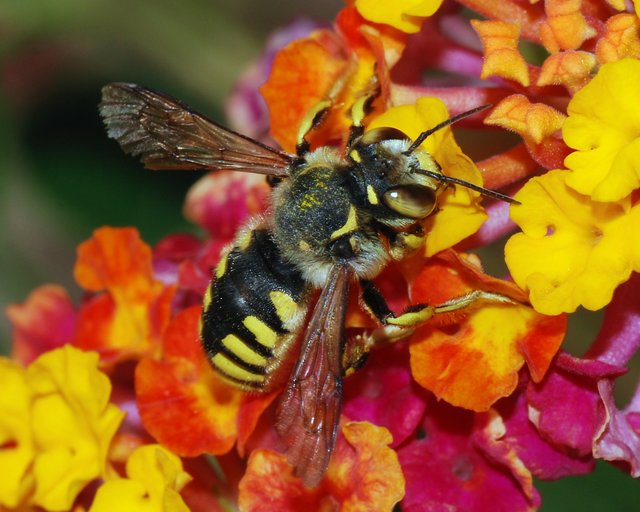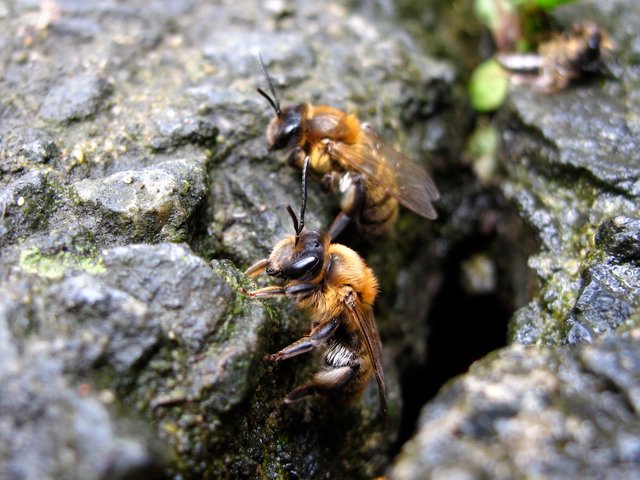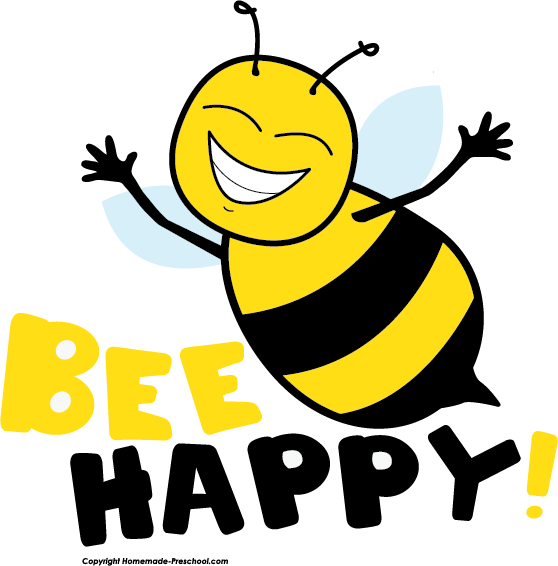
Bees are flying insects closely related to wasps and ants. There are nearly 20,000 known species of bees in seven to nine recognized biological families.
Human beekeeping or apiculture has been practised for millennia, since at least the times of Ancient Egypt and Ancient Greece.
Sociality
Bees may be solitary or may live in various types of communities. Sociality, of several different types, appears to have evolved independently many times within the bees.
Eusociality
The most advanced of these are species with eusocial colonies; these are characterised by having cooperative brood care and a division of labour into reproductive and non-reproductive adults, plus overlapping generations.
This division of labour creates specialized groups within eusocial societies which are called castes. In some species, groups of cohabiting females may be sisters, and if there is a division of labour within the group, they are considered semisocial.

Many bumblebees are eusocial such as many termites, ants, and wasps.
Solitary and communal
Most solitary bees nest in the ground in a variety of soil textures and conditions while others create nests in hollow reeds or twigs, holes in wood. The female typically creates a compartment (a "cell") with an egg and some provisions for the resulting larva, then seals it off. A nest may consist of numerous cells. When the nest is in wood, usually the last (those closer to the entrance) contain eggs that will become males. The adult does not provide care for the brood once the egg is laid, and usually dies after making one or more nests.
While solitary females each make individual nests, some species are gregarious, preferring to make nests near others of the same species, and giving the appearance of being social.
Large groups of solitary bee nests are called aggregations, to distinguish them from colonies. In some species, multiple females share a common nest, but each makes and provisions her own cells independently. This type of group is called "communal" and is not uncommon.

The primary advantage appears to be that a nest entrance is easier to defend from predators and parasites when there are multiple females using that same entrance on a regular basis.
Solitary bees are important pollinators; they gather pollen to provision their nests with food for their brood.
Superorganism
A superorganism is an organism consisting of many organisms such as a body composed of cells or such as a beehive composed of bees.
The term superorganism is used most often to describe a social unit of eusocial animals, where division of labour is highly specialised and where individuals are not able to survive by themselves for extended periods.
Ants are the best-known example of such a superorganism. A superorganism can be defined as "a collection of agents which can act in concert to produce phenomena governed by the collective".
Bees exhibit a form of "distributed intelligence", a system in which many individual agents with limited intelligence and information are able to pool resources to accomplish a goal beyond the capabilities of the individuals.
This distributed intelligence is certainly one of the most important evolutional tool that have permit bees to survive along time in despit of predators and parasites.
This pattern have majorly influanced and improved domains such as cybernetics, management applications, and blockchain technologies.
Nocturnal bees
Some bee families contain some species that are crepuscular. Most are tropical or subtropical, but there are some which live in arid regions at higher latitudes.
These bees have greatly enlarged ocelli, which are hypersensitive to light and dark, though incapable of forming images. Some have refracting superposition compound eyes: these combine the output of many elements of their compound eyes to provide enough light for each retinal photoreceptor.
Their ability to fly by night enables them to avoid many predators, and to exploit flowers that produce nectar only or also at night.
Ecology
Bees perform about 80% of all pollination worldwide. A single bee colony can pollinate 300 million flowers each day. Grains are primarily pollinated by the wind, but the best and healthiest food such as fruits, nuts, and vegetables are pollinated by bees. Seventy out of the top 100 human food crops, which supply about 90% of the world's nutrition, are pollinated by bees.

Tonio Borg, European Commissioner for Health and Consumer Policy, calculates that bees "contribute over €22bn ($30bn US dollars) annually to European agriculture." Worldwide, bees pollinate human food valued at over €265bn ($350bn). The bee collapse is a challenge to human enterprise on the scale of global heating, ocean acidification, and nuclear war. Humans could not survive a bee collapse.
Conclusion
Bees often get a bad reputation in the mainstream media and among people, many people see bees as usless or even dangerous.

But the fact is that bees are a species that save us from extinction and provide use the rich and abundant varities of food that we have the chance to have.
Superorganism among social bees and capacity to see in the dark among noctural bees are the two main survival tools that have permit bees to survive along time in despit of parasites and predators.
Without theses, nobody would be there to write or read this article or even breath.

Sources: Bee wikipedia, Superorganism wikipedia, Greenpeace
I use quite a bit of honey in my sweets, the natural flavor really gives a depth of flavor that is wonderful. Without bees to regulate the health of the ecosystem, we would loose out on much more than just a sweetener. Thank you for spreading this information!
Downvoting a post can decrease pending rewards and make it less visible. Common reasons:
Submit
Excellent article!
Downvoting a post can decrease pending rewards and make it less visible. Common reasons:
Submit
Cool!
Downvoting a post can decrease pending rewards and make it less visible. Common reasons:
Submit
Congratulations @phi-legacy! You received a personal award!
You can view your badges on your Steem Board and compare to others on the Steem Ranking
Do not miss the last post from @steemitboard:
Vote for @Steemitboard as a witness to get one more award and increased upvotes!
Downvoting a post can decrease pending rewards and make it less visible. Common reasons:
Submit
Downvoting a post can decrease pending rewards and make it less visible. Common reasons:
Submit